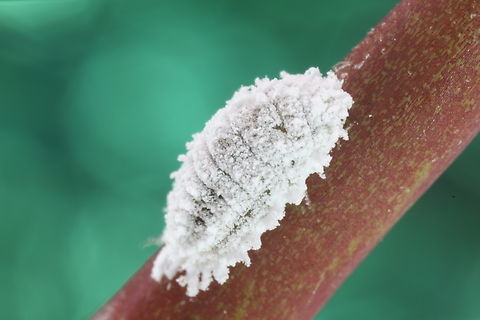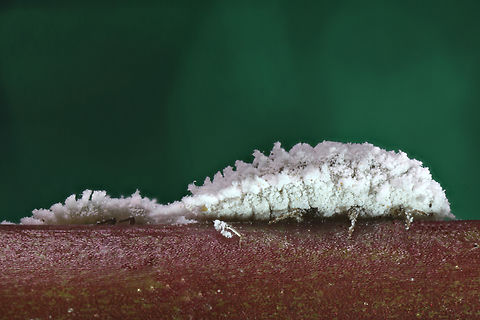
Appearance
Mealybugs are sexually dimorphic. The adult female citrus mealybug is about 3 mm long with a white, brownish, or pink body covered in white wax. The edges of the body are lined with waxy filaments. It has a light gray longitudinal line down its back. Its legs and antennae are brown. The adult female lacks wings and resembles a nymph. The adult male is slightly larger, has long wax filaments on the posterior end of the body, and has functional wings. In flight the male resembles a gnat.The female deposits masses of eggs on plants. The masses, known as ovisacs, are covered in fluffy, cottony layers of wax filaments. The ovisac can contain up to 20 shiny yellowish, pink, or amber eggs each about 0.3 mm long. The first-instar nymph is called a crawler. It is yellowish with red eyes and has a wax coating. Crawlers are active and gregarious. The female nymph resembles the adult female, while the male nymph is longer and narrower. As they develop, the female nymph progresses through more instars than the male, and the male undergoes a pre-pupal stage. The male constructs a cottony cocoon for pupation, and the female does not.
The citrus mealybug looks very similar to the vine mealybug, and the two species are mainly distinguished by the arrangement of pores and tubular ducts on the tiny body of the female. This similarity can pose a problem in agriculture. For example, when growers are ready to attempt biological pest control of either mealybug, the use of molecular analysis is recommended to confirm the identity of the species so an appropriate parasitoid can be employed.

Behavior
The longevity of the adult depends on temperature, but while females live for several weeks, males live fewer than three days in adult form. During this time, the male does not feed. It takes flight with its single pair of wings and seeks females. The female spends its longer lifetime feeding and producing eggs. Most other aspects of the life cycle depend on temperature, as well, including egg mortality, nymph mortality, rate of development, sex ratio, fecundity, and the length of the egg-laying period.During mating, the citrus mealybug is known to engage in "triple coitus"; a female may copulate with two males at the same time, and a third male may at least make attempts to join the process. Males spend the one or two days of their adult lives mating, and have been observed achieving copulation with up to 23 females, with an average of about nine.
There are usually several generations per year. The mealybug is most common in spring and summer, its populations fluctuating according to temperature and available host plants. Peak abundance is noted in early summer in Florida citrus. Mealybugs infesting plants in the constant conditions of greenhouses have stable, steadily reproducing populations all year.
All mealybug species investigated so far have endosymbionts: symbiotic bacteria that live inside their bodies and synthesize useful compounds such as amino acids that the insect can utilize. Most mealybugs examined contain the betaproteobacterium "Tremblaya princeps". Other bacterial taxa have recently been found in mealybugs, as well. The citrus mealybug has a nested endosymbiosis. Its resident "T. princeps" contain their own endosymbionts, the gammaproteobacterium "Moranella endobia". This "matryoshka" nested arrangement of a bacterium inside a bacterium inside an insect has been compared to the structure of a cell. "T. princeps" has almost no metabolic functions except for the production of amino acids, having lost the genes for most other life functions. It relies on "M. endobia" for energy, and is even unable to reproduce without it. "T. princeps" attracted attention when genetic analysis revealed that it has the smallest genome of any bacterium studied thus far. At 139 kilo-base pairs, it has only about 120 genes, which helps to explain why it cannot function without its endosymbiont.
References:
Some text fragments are auto parsed from Wikipedia.